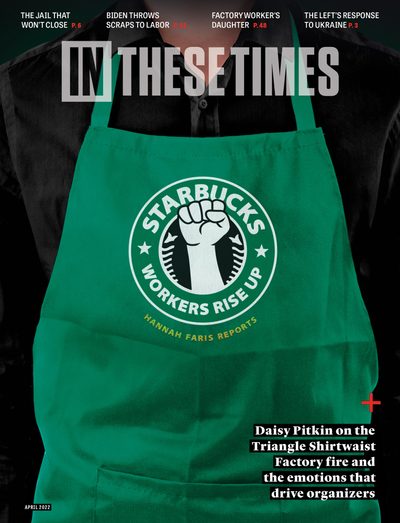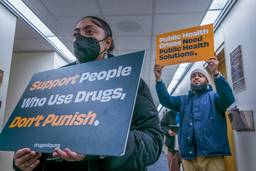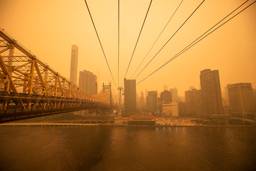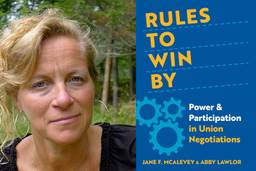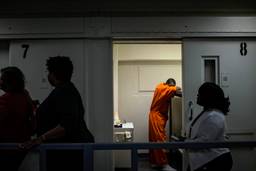Meet the High School Students Who Organized Thousands to Walk Out for Amir Locke
Twin Cities teens demand a true ban on deadly “no-knock” warrants, a broken promise from Mayor Frey.
Paige Oamek and Maggie Duffy
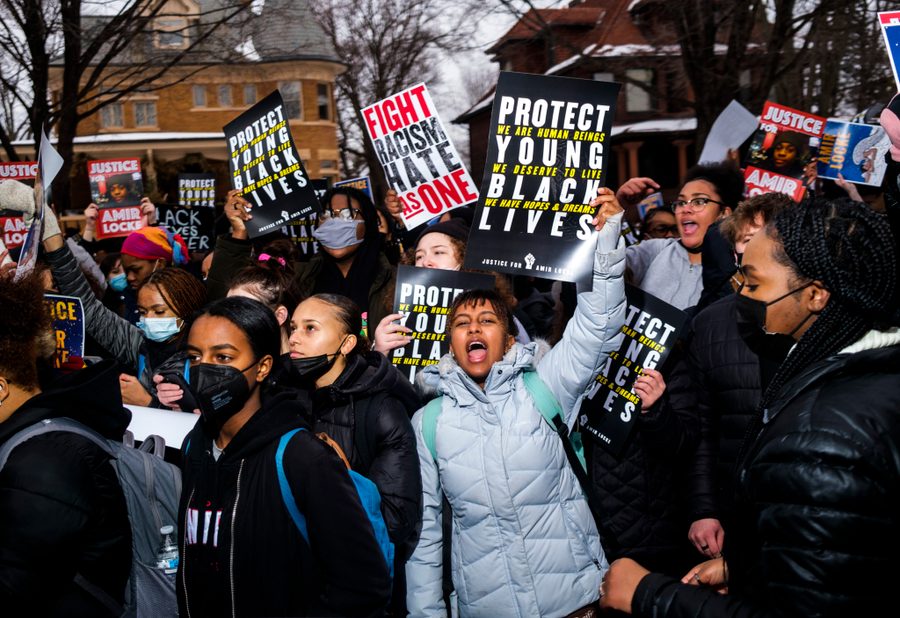
More than 3,000 high school students from across the Twin Cities metro area in Minnesota walked out of class February 8 to march to the governor’s mansion and demand justice following the death of Amir Locke.
Locke, a 22-year-old Black man, was shot and killed February 2 by a Minneapolis Police Department SWAT officer during a no-knock apartment raid. Locke was neither named in the no-knock warrant nor a resident of the apartment.
In an area beset by the police killings of Black residents — including 46-year-old George Floyd in May 2020 — Locke’s death sparked marches and car caravans across the Twin Cities.
Twin Cities high school students organized quickly through social media to demand the demilitarization of the Minneapolis Police Department, the resignation of those culpable in the killing of Amir Locke, and a ban on no-knock warrants. Their demonstration garnered even more attendees than the downtown protest held the night before.
Student organizers who spoke with In These Times voiced anger at the system responsible for the killing and at their city leaders, who they say have failed to protect residents from a violent police force.
“The system is quite literally working how it’s supposed to work,” Ezra Hudson, 17, a leader of MN Teen Activists, tells In These Times over the phone a day after the walkout. “Oftentimes they’re not going to reach the final answer and safest answer for the Black community.”
Hudson got involved with racial justice organizing in his first year of high school, joining the group Students Organized Against Racism at St. Louis Park High School, in a Minneapolis suburb. He co-founded the nonprofit MN Teen Activists his sophomore year. As a senior, Hudson has helped organize multiple walkouts around Minnesota.
“I think the key is being conscious enough to see why you have to keep going,” Hudson says.
Some of the student leaders were politicized by events that were traumatizing on a personal level. Sandra Tougnon, 18, co-founded the Black Student Union at Central High School in St. Paul in 2021 in collaboration with a friend. At the time, “We didn’t have the space to talk about issues or what was happening,” Tougnon tells In These Times. Her motivation was to create a space for other Black students who were feeling similarly — “who look like me, who deserve that community,” she explains. Central’s Black Student Union now has 40 members and, according to Tougnon, is growing by the week.
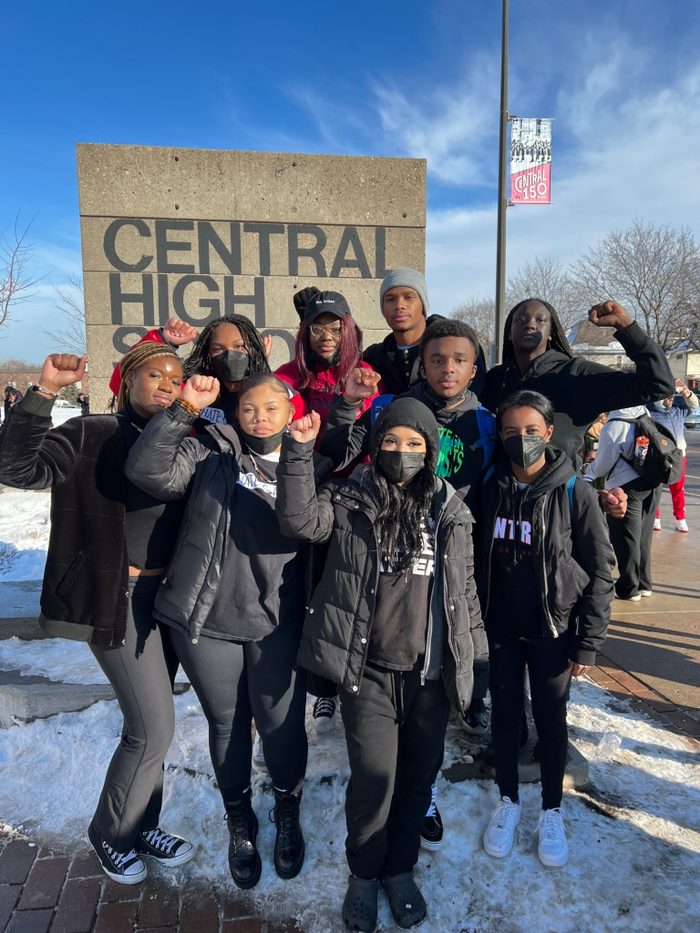
While the high school students’ walkout escalated quickly, it took behind-the-scenes coordination across schools to pull off.
Tougnon credits one of Central’s Black Student Union members, Grace Mutombo, with organizing the walkout. After attending a protest for Amir Locke in downtown Minneapolis, Mutombo asked Black Student Union members what they thought of organizing their own protest. “She was thinking about how this has affected her and other youth in our community,” Tougnon says. Grace reached out to another activist, Chauntyll Allen, who put Central’s Black Student Union in touch with Jerome Treadwell, executive director of MN Teen Activists.
Students from Central’s Black Student Union and MN Teen Activists met over Google Meet on February 6 and 7 to organize. Tougnon says the students’ six demands arose from two questions: “What led to this situation?” and “How can this situation never occur again?”
The students’ demands include a complete ban on no-knock warrants and a full overhaul of the Minneapolis Police Department — to, as Tougnon says, “re-evaluate the practices of the MPD.” Another demand, to demilitarize the MPD, aims to “rebuild the police system and base it on collective care for all,” Tougnon says.
The students are also calling for a full review of MPD and SWAT practices, the resignation of MPD’s Interim Police Chief Amelia Huffman, the resignation of Mayor Jacob Frey and accountability from Judge Peter Cahill, who approved the no-knock warrant that led to the death of Amir Locke. Some are calling for Cahill’s resignation.
On February 2, Locke was shot and killed by MPD officer Mark Hanneman during the no-knock raid. Originally, St. Paul police had requested a “knock and announce warrant” to be carried out jointly with the MPD SWAT team, but that warrant was never executed. Instead, a separate no-knock warrant was filed by MPD and approved by Cahill, the same judge who presided over the trial of former MPD officer Derek Chauvin, who murdered George Floyd.
This no-knock warrant is the same type of warrant Mayor Frey had once claimed to have banned, through a November 2020 policy, in Minneapolis. By April 2021, however — after a botched SWAT raid ended in a family being held at gunpoint — Frey clarified the policy had exceptions for “exigent circumstances” and for the county SWAT team. (An archived version of Frey’s election campaign website shows that, as recently as Oct. 23, 2021, the Frey administration claims the ban on no-knock warrants as an accomplishment.) Frey was reelected in 2021 with 49.1% of the vote; a ballot measure to replace the MPD was voted down in the same election.
MPD, meanwhile, has applied for no fewer than 90 no-knock warrants since the mayor’s purported November 2020 ban. In September 2021, Minnesota passed a law that required police departments to report the number of no-knock search warrants requested, the number issued and the number executed. Data from the Minnesota Department of Public Safety shows that, between September 2021 and February 2, the MPD executed at least eight no-knock warrants under Frey’s leadership. (Because the agency is allowed three months to report, the number is likely low.) Frey’s own reporting suggests a higher number: The mayor’s office told the Intercept that MPD has served 11 no-knock warrants between January 1 and February 8. It’s unclear which of these warrants was carried out by SWAT (MPD did not immediately respond to a request for comment), as the state tracks data based on which agency reported the warrant, rather than who carried out the warrant.
Data also shows that Black people are disproportionately targeted by aggressive police raids. According to an American Civil Liberties Union report from 2014, nationwide, 42% of those “impacted by a SWAT deployment to execute a search warrant” were Black. In Minnesota, while only 7% of the population is Black, MinnPost finds that 70% of subjects of executed no-knock warrants from September 2021 through February 2 were Black.
The police killing of Amir Locke — and the actions of Frey, Cahill and Hanneman — illustrate too clearly a continual failure of the state to protect Black people, students say. The clarity of the students’ demands stand in stark contrast with the confusion around the 2021 police overhaul ballot measure and Frey’s claim that he already banned no-knock warrants.
Following the shooting of Amir Locke, Frey addressed the warrant issue again, saying his language had at times been too “casual” in explaining the change in the city’s policy on no-knock warrants. Some argue that Frey’s talking point was used not only in service of his reelection — but to prove a more radical solution was unnecessary.
Tougnon says it is time to “re-strategize and say this is not working.”
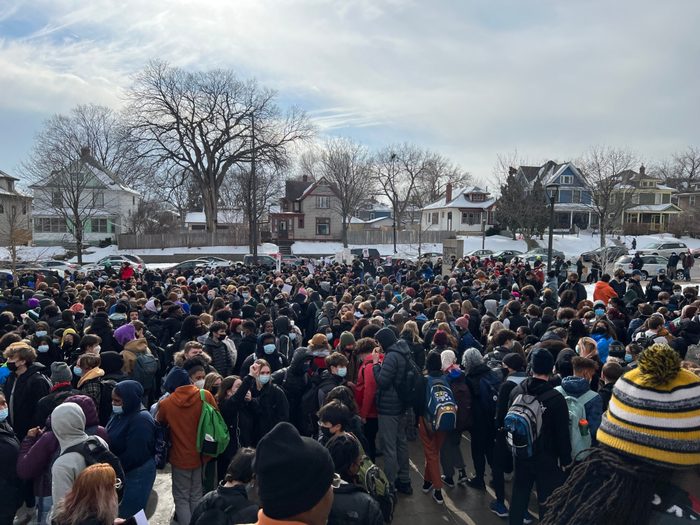
“I think a lot of lack of action is rooted in deeper problems,” says Ezra Hudson of MN Teen Activists. “It’s some deep unrooting that we’re going to have to do.” Hudson cites the 1963 Children’s March as an example of the importance of youth movements and walkouts in U.S. history, which ended with President John F. Kennedy’s support for federal civil rights legislation and the eventual passage of the Civil Rights Act of 1964.
The plans for the walkout only included students from Central High School and members of MN Teen Activists — at first. Then, on February 6, Hudson reached out to Jerome Treadwell, executive director of MN Teen Activists, asking if St. Louis Park High School students could join.
Treadwell responded, “I think we might as well try to make it statewide.”
Ultimately, students mostly filed in from across the Twin Cities metro area, but Hudson says word spread fast.
“Jerome made a flier, I put it on my [Instagram] story, other people started spreading it,” Hudson says. “We started getting tons and tons of people swiping up saying, ‘I’ll bring my school, I’ll bring these people.’ Come Tuesday, we had like two- or three-thousand people there.”
According to Tougnon, more than 3,000 students walked out of school February 8, including students from St. Louis Park, Benilde-St. Margaret’s, Breck, Hopkins, Patrick Henry, North, Cretin-Derham Hall, Roosevelt and Washburn. Participants first convened at Central High School before marching to Gov. Tim Walz’s house to make demands.
Tougnon says the response was overwhelming: “Knowing that people are with me, with us, we just all have one message — that was really amazing.”
Teens like Hudson and Tougnon have come of age during a new public awareness of police brutality and racial reckoning. Tougnon cites the experience of fearing for her life as a girl after the fatal shooting of Trayvon Martin 10 years ago. As a child, she remembers running outside in the cold Minnesota air, wanting to put up her hoodie but “instantly decided against it” — because if “Trayvon Martin couldn’t” be safe, how could she know she would be?
Tougnon adds that the murder of George Floyd in 2020 was “a huge wake-up call,” forcing her and others “to come to terms with the racism that was deeply rooted in our system.”
Though the walkout’s aim was to influence community support and changes from local officials, students want to advocate for change in their schools as well.
A few weeks ago, Tougnon and the Black Student Union held a segregation forum about the racial divide they see in enrollment for advanced classes — in a school setting where the higher-track classes are physically higher in the building. “As you get higher in the building … it gets less colorful,” Tougnon says. “People who look like me are directed towards the lower classes,” located in the physically lower parts of the school.
Tougnon explains that, as one of the only students of color in her advanced classes, she has had to advocate for herself. A 2019 report from the Federal Reserve Bank of Minneapolis found that Minnesota has one of the worst achievement gaps in the country in terms of race and socio-economic status.
Tougnon reiterates support for other teens hoping to form organizations in their high schools. “Creating a community is so powerful,” Tougnon says, “leaving a legacy for the generation that’s coming.” Hudson lifts up what he calls “solo activists” who haven’t yet found a political home, and both encourage young people to build community and to support each other through what can be the exhausting and traumatizing work of organizing.
“We’re fighting for the people, but we’re also fighting for ourselves and fighting for our own lives,” Hudson says. “That takes a mental toll on you.”
Hudson also notes the steps MN Teen Activists has taken to prioritize both community and self-care. “At first we were kind of just like, ‘go, go, go,’ but never really taking the time to realize how this has mentally impacted us.” Now, Hudson says MN Teen Activists recognize they will only succeed if they are “physically being out there and also mentally being at home and resting.”
Hudson also emphasizes the importance of recharging. “I think that’s something people often forget to do,” Hudson says. “Just clear your head and just let you be you for a second.”
The students have yet to receive a response from officials about their walkout. In the meantime, they are present on social media, connecting with fellow activists and asking people to text “Amir” to 33777 to receive updates from MN Teen Activists, take action and continue to raise awareness of their demands.
Hudson says they plan to hold future walkouts as well: “At the end of the day, [walkouts] force people to pay attention, they create change and they show that we want change.”
While they monitor reactions from their most recent action, Hudson and Tougnon are eyeing the future. “I think down the line we want to do some more national stuff,” Hudson says. “Garner some more attention to garner some more power to push more on issues.”
“It doesn’t end here,” Tougnon reassures. “It does not.”
Paige Oamek is a writer and fact-checker based in New York. Their writing appears in The Nation, The American Prospect and elsewhere.
Maggie Duffy is a Brooklyn-based writer and an In These Times editorial intern. She is a graduate of Occidental College where she earned a degree in sociology. She most recently worked as a researcher for American Friends Service Committee.
